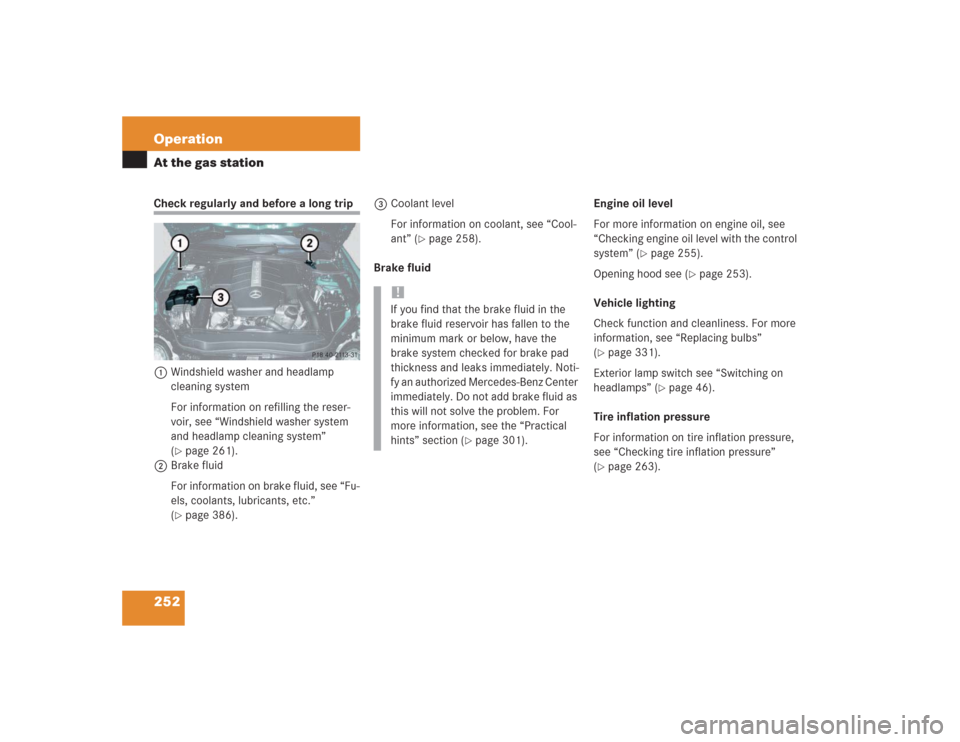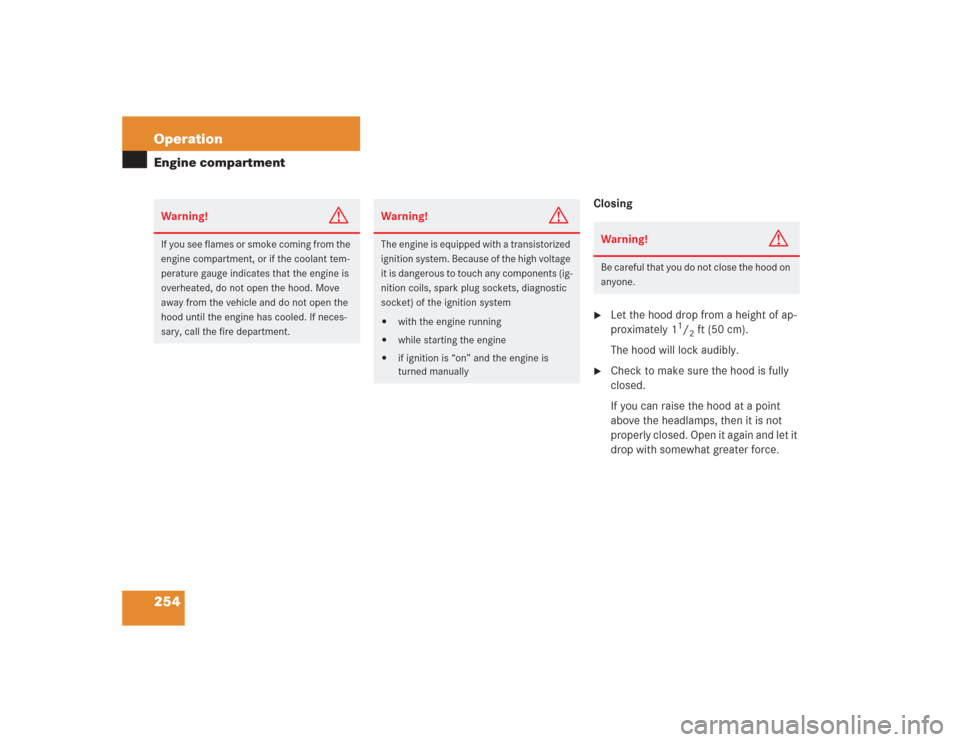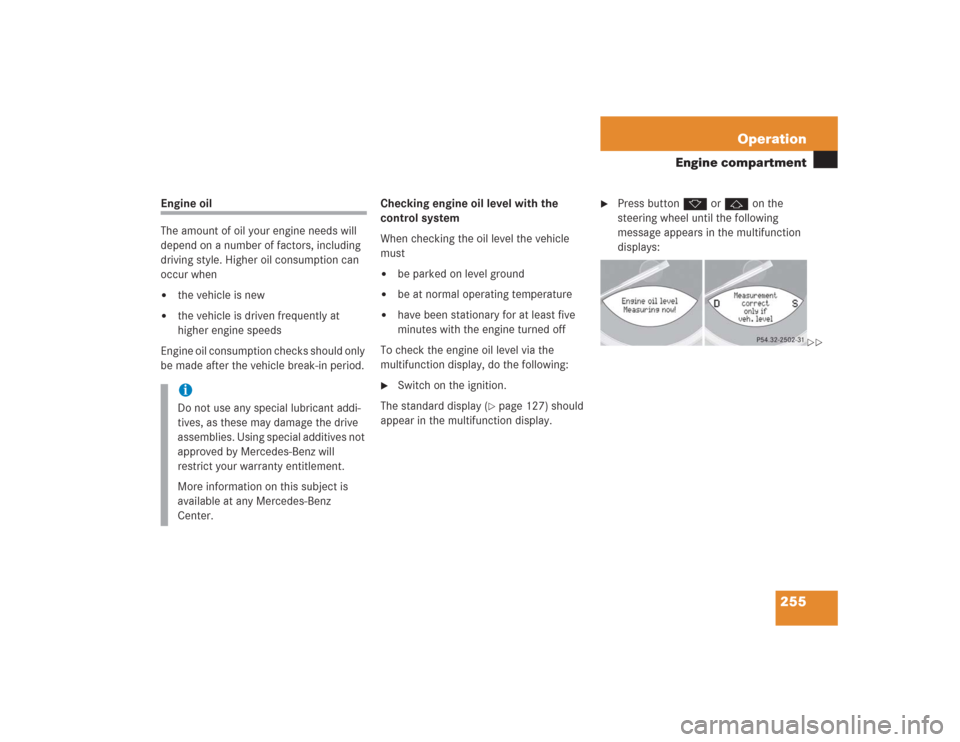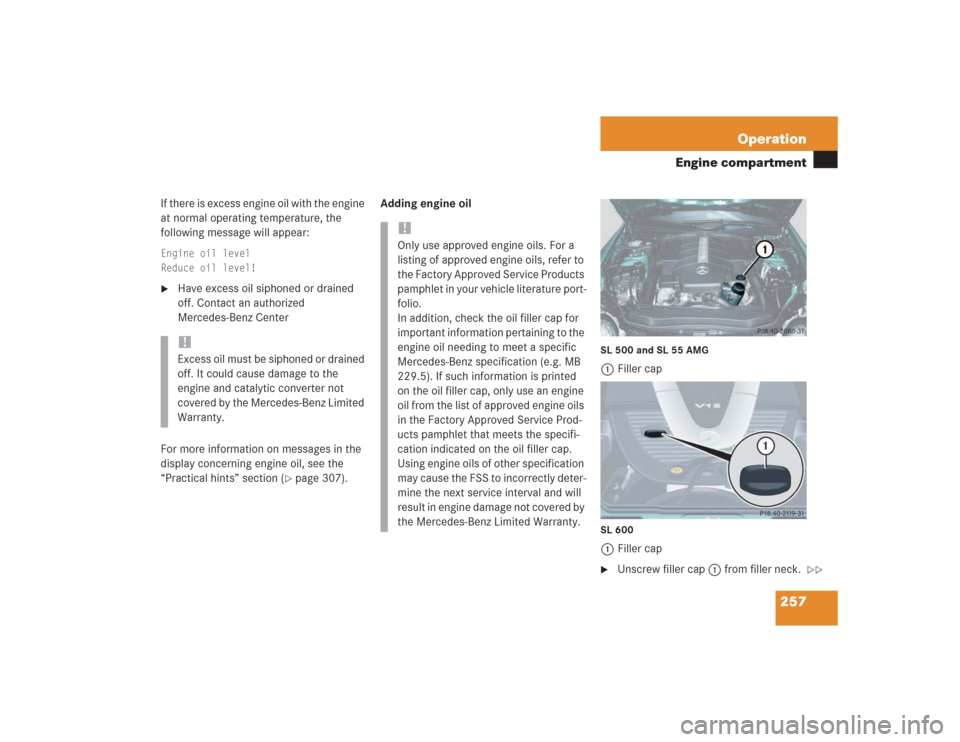Page 242 of 434

241 Operation
Driving instructions
To help prevent brake disk corrosion after
driving on wet road surfaces (particularly
salted roads), it is advisable to brake the
vehicle with considerable force prior to
parking. The heat generated serves to dry
the brakes.
If your brake system is normally only sub-
jected to moderate loads, you should occa-
sionally test the effectiveness of the
brakes by applying above-normal braking
pressure at higher speeds. This will also
enhance the grip of the brake pads.
If the parking brake is released and the
brake warning lamp in the instrument clus-
ter stays on, there is a malfunction in the
SBC brake system (
�page 81) or the
brake fluid level in the reservoir is too low.Brake pad wear or a leak in the system may
be the reason for low brake fluid in the res-
ervoir.
Have the brake system inspected immedi-
ately.
All checks and service work on the brake
system should be carried out by qualified
technicians only. Contact an authorized
Mercedes-Benz Center.
Only install brake pads and brake fluid rec-
ommended by Mercedes-Benz.After hard braking, it is advisable to drive
on for some time, rather than immediately
parking, so the air stream will cool down
the brakes faster.
!Be very careful not to endanger other
road users when you apply the brakes.
Refer to the description of the Brake
Assist System (BAS) (
�page 77).
Warning!
G
If other than recommended brake pads are
installed, or other than recommended brake
fluid is used, the braking properties of the
vehicle can be degraded to an extent that
safe braking is substantially impaired. This
could result in an accident.
Be certain to read and observe the warning
notices on brake pad replacement
(�page 82).
!When driving down long and steep
grades, relieve the load on the brakes
by shifting into a lower gear to use the
engine’s braking power. This helps pre-
vent overheating of the brakes and re-
duces brake pad wear.
Page 253 of 434

252 OperationAt the gas stationCheck regularly and before a long trip
1Windshield washer and headlamp
cleaning system
For information on refilling the reser-
voir, see “Windshield washer system
and headlamp cleaning system”
(
�page 261).
2Brake fluid
For information on brake fluid, see “Fu-
els, coolants, lubricants, etc.”
(�page 386).3Coolant level
For information on coolant, see “Cool-
ant” (
�page 258).
Brake fluidEngine oil level
For more information on engine oil, see
“Checking engine oil level with the control
system” (
�page 255).
Opening hood see (
�page 253).
Vehicle lighting
Check function and cleanliness. For more
information, see “Replacing bulbs”
(
�page 331).
Exterior lamp switch see “Switching on
headlamps” (
�page 46).
Tire inflation pressure
For information on tire inflation pressure,
see “Checking tire inflation pressure”
(
�page 263).
!If you find that the brake fluid in the
brake fluid reservoir has fallen to the
minimum mark or below, have the
brake system checked for brake pad
thickness and leaks immediately. Noti-
fy an authorized Mercedes-Benz Center
immediately. Do not add brake fluid as
this will not solve the problem. For
more information, see the “Practical
hints” section (
�page 301).
Page 255 of 434

254 OperationEngine compartment
Closing�
Let the hood drop from a height of ap-
proximately 1
1/2ft (50 cm).
The hood will lock audibly.
�
Check to make sure the hood is fully
closed.
If you can raise the hood at a point
above the headlamps, then it is not
properly closed. Open it again and let it
drop with somewhat greater force.
Warning!
G
If you see flames or smoke coming from the
engine compartment, or if the coolant tem-
perature gauge indicates that the engine is
overheated, do not open the hood. Move
away from the vehicle and do not open the
hood until the engine has cooled. If neces-
sary, call the fire department.
Warning!
G
The engine is equipped with a transistorized
ignition system. Because of the high voltage
it is dangerous to touch any components (ig-
nition coils, spark plug sockets, diagnostic
socket) of the ignition system�
with the engine running
�
while starting the engine
�
if ignition is “on” and the engine is
turned manually
Warning!
G
Be careful that you do not close the hood on
anyone.
Page 256 of 434

255 Operation
Engine compartment
Engine oil
The amount of oil your engine needs will
depend on a number of factors, including
driving style. Higher oil consumption can
occur when�
the vehicle is new
�
the vehicle is driven frequently at
higher engine speeds
Engine oil consumption checks should only
be made after the vehicle break-in period.Checking engine oil level with the
control system
When checking the oil level the vehicle
must
�
be parked on level ground
�
be at normal operating temperature
�
have been stationary for at least five
minutes with the engine turned off
To check the engine oil level via the
multifunction display, do the following:
�
Switch on the ignition.
The standard display (
�page 127) should
appear in the multifunction display.
�
Press buttonk orj on the
steering wheel until the following
message appears in the multifunction
displays:
iDo not use any special lubricant addi-
tives, as these may damage the drive
assemblies. Using special additives not
approved by Mercedes-Benz will
restrict your warranty entitlement.
More information on this subject is
available at any Mercedes-Benz
Center.
��
Page 257 of 434

256 OperationEngine compartment
One of the following messages will
subsequently appear in the right multi-
function display:�
Engine oil level
OK
�
Add 1.0 qt. for
max. oil level(Canada:
1.0 l
)
�
Add 1.5 qts. for
max. oil level(Canada:
1.5 l
)
�
Add 2.0 qts. for
max. oil level(Canada:
2.0 l
)
�
If necessary, add engine oil.
For adding engine oil see (
�page 257).
For more information on engine oil, see the
“Technical data” section (
�page 386) and
(
�page 388).
Other display messages
If the SmartKey or the KEYLESS-GO*
start/stop button is not in position2, the
following message will appear:
Ignit. on to measure
engine oil level�
Switch on ignition.If you see the message:
Observe waiting time�
If engine is at normal operating
temperature, wait five minutes before
repeating the check procedure.
�
If engine is not yet at normal operating
temperature, wait 30 minutes before
repeating the check procedure.
If you see the message:
Engine oil level
Not when engine on
!
�
Turn off the engine.
�
If the engine is at normal operating
temperature, wait five minutes before
checking oil.
�
If the engine is not yet at normal
operating temperature, you must wait
30 minutes before checking oil.
iIf you want to interrupt the checking
procedure, press thek orj
button on the multifunction steering
wheel.
��
Page 258 of 434

257 Operation
Engine compartment
If there is excess engine oil with the engine
at normal operating temperature, the
following message will appear:Engine oil level
Reduce oil level!�
Have excess oil siphoned or drained
off. Contact an authorized
Mercedes-Benz Center
For more information on messages in the
display concerning engine oil, see the
“Practical hints” section (
�page 307). Adding engine oil
SL 500 and SL 55 AMG1Filler capSL 6001Filler cap�
Unscrew filler cap1 from filler neck.
!Excess oil must be siphoned or drained
off. It could cause damage to the
engine and catalytic converter not
covered by the Mercedes-Benz Limited
Warranty.
!Only use approved engine oils. For a
listing of approved engine oils, refer to
the Factory Approved Service Products
pamphlet in your vehicle literature port-
folio.
In addition, check the oil filler cap for
important information pertaining to the
engine oil needing to meet a specific
Mercedes-Benz specification (e.g. MB
229.5). If such information is printed
on the oil filler cap, only use an engine
oil from the list of approved engine oils
in the Factory Approved Service Prod-
ucts pamphlet that meets the specifi-
cation indicated on the oil filler cap.
Using engine oils of other specification
may cause the FSS to incorrectly deter-
mine the next service interval and will
result in engine damage not covered by
the Mercedes-Benz Limited Warranty.
��
Page 259 of 434

258 OperationEngine compartment�
Add engine oil as required. Be careful
not to overfill with oil.
Be careful not to spill any oil when adding.
Avoid environmental damage caused by oil
entering the ground or water.
�
Screw filler cap1 back on filler neck.
For more information on engine oil, see the
“Technical data” section (
�page 386) and
(
�page 388).
Transmission fluid level
The transmission fluid level does not need
to be checked. If you notice transmission
fluid loss or gear shifting malfunctions,
have an authorized Mercedes-Benz Center
check the automatic transmission. Oil level in the ABC system
The oil level in the ABC system does not
need to be checked. If there is visible oil
loss or if malfunction messages appear in
the display, have an authorized
Mercedes-Benz Center check the ABC
system.
Coolant
!Excess oil must be siphoned or drained
off. It could cause damage to the
engine and catalytic converter not
covered by the Mercedes-Benz Limited
Warranty.
Warning!
G
In order to avoid any possibly serious burns:�
Use extreme caution when opening the
hood if there are any signs of steam or
coolant leaking from the cooling system,
or if the coolant temperature gauge indi-
cates that the coolant is overheated.
�
Do not remove pressure cap on coolant
reservoir if engine temperature is above
158°F (70°C). Allow engine to cool
down before removing cap. The coolant
reservoir contains hot fluid and is under
pressure.
�
Using a rag, slowly open the cap approx-
imately
1/2 turn to relieve excess pres-
sure. If opened immediately, scalding
hot fluid and steam will be blown out un-
der pressure.
�
Do not spill antifreeze on hot engine
parts. Antifreeze contains ethylene gly-
col which may burn if it comes into con-
tact with hot engine parts.
��
Page 260 of 434
259 Operation
Engine compartment
The engine coolant is a mixture of water
and anticorrosion/antifreeze. To check
the coolant level, the vehicle must be
parked on level ground and the engine
must be cool.
The coolant expansion tank is located on
the passenger side of the engine compart-
ment.
1Coolant expansion tank
�
Using a rag, turn the cap slowly approx-
imately one half turn to the left to re-
lease any excess pressure.
�
Continue turning the cap to the left and
remove it.
The coolant level is correct if the level
�
for cold coolant: is up to the upper
mark on the bracing rib of the coolant
expansion tank (translucent)
�
for warm coolant: is approx. 0.6 in
(1.5 cm) higher
�
Add coolant as required.
�
Replace and tighten cap.
For more information, see “Coolants”
(
�page 391).!SL 600: Only open the cap on coolant
expansion tank1. Never open the cap
between the two charge-air coolers.
Otherwise, the engine could be dam-
aged.